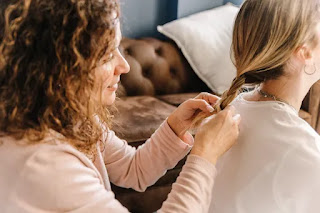Introduction:
Hair extensions are an easy way to get longer, thicker hair without the commitment of a big chop. The process can be expensive, but it's worth it if you want the extra length and volume. In this post, I'll explain how hair extensions work and what types of extensions are available so that you can find out if they're right for you!
Most hair extensions are made from real human hair.
Most hair extensions are made from real human hair. That's because they're the most natural-looking and versatile option when it comes to changing up your look, both in terms of texture and color.
Human hair extensions come in many textures, including straight, wavy or curly/kinky (AKA "slightly wavy"). While some textures are more common than others, you can get any type of human hair extension you want—as long as it's real!
Hair extensions that are made from synthetic fibers are much cheaper than extensions made from real human hair.
However, there are some drawbacks: synthetic fibers aren't as durable as real ones; they tend to get tangled more easily; they won't last nearly as long; they don't hold styles like natural hairs do; and they may not look as natural on your head (because if you have curly/kinky tresses like me then those kinks will still show through).
Extensions come in all different lengths, colours, textures and styles.
Extensions come in all different lengths, colours, textures and styles. Hair extensions are typically attached with keratin bonds that are strong enough to withstand daily wear along with heat styling tools like flat irons or curling irons. There are also some adhesive options available for those who don’t want to use keratin bonds.
If you have short hair but would like the option of wearing long locks for special occasions or when going out for the night, clip-in extensions can be a simple solution that gives you instant length without having to commit to more permanent solutions like microbonding (also called microlinks) which involves tiny tubes being inserted into your natural hair at each strand root and then bonded together by an adhesive resin that is usually removed after about three months (though removal takes about 20 minutes).
Many types of extensions can be cut and styled just like your own hair.
Extensions can be cut and styled just like your own hair. You can also dye, curl and straighten them. How to style your extensions:
Using a comb, separate hair into sections (using clips if needed) and begin with the bottom layer of hair by parting it down the middle.
Then take small sections from each side of the part and secure them around 1/4 inch from scalp using a mini hook clip (available at Sally Beauty Supply stores). If you prefer not to use clips, secure the pieces with bobby pins instead — just be sure that when all is said and done, there are no gaps between pieces of hair showing through on top of each other!
Extensions can be attached by weaving, glue or tape.
Weaving is the most common method of attaching hair extensions. This method involves sewing a weft of extension thread onto your natural hair at intervals that are determined by your desired length and overall style. This type of attachment works best for long, straight or slightly wavy hair as it blends seamlessly with your natural texture to create a seamless look.
Glue on extensions are often used for shorter styles and may be applied directly to the scalp, secured using tape or staples before being covered with layers of extensions (either human or synthetic).
Tape in extensions are less popular than other types since they can be difficult to remove and may cause damage if not properly applied; however they provide an excellent option for short styles because they do not require any heat styling tools (a huge bonus if you have fine hair)
Hair extensions are more involved and expensive than simply dying your hair, but the result is worth it!
The process is more complex than dying your hair. For example, you can’t just dye a chunk of your own hair and wrap it around some clip-ins: You have to find an experienced stylist who understands how to style these things on every individual head shape. Your colorist also has to be careful not to damage the existing strands of hair so that they stay healthy after being used in this way.
Additionally, these products aren’t cheap—but like anything else in life, you get what you pay for! Hair extensions are one of those things where paying less often means sacrificing quality or longevity (or both). If you want something that will last for years and stand up against heat styling tools like flat irons then expect to spend at least $1k per set on good quality extensions.
Conclusion:
We hope that after reading this article you now have a better understanding of what hair extensions are and the many different types of extension that are available. If you're thinking about trying out some new hair styles or adding length to your own locks, we would highly recommend visiting your local salon or beauty supply store to see what they have available. You might even find something new that will inspire your next big change!





Post a Comment
If you have any query. Please let me know